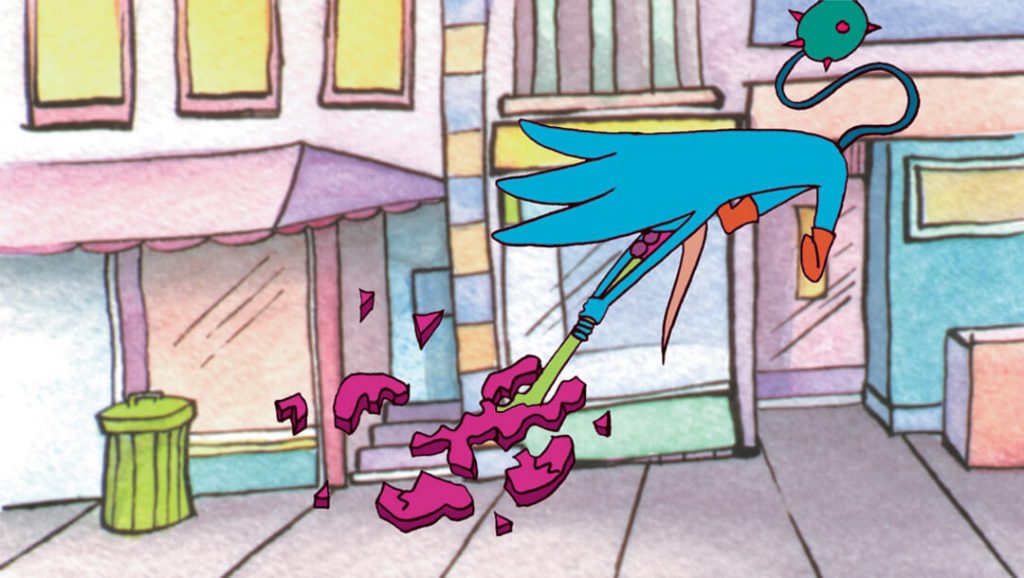
Flip-Books
Vered Eliezri Ganchrow
Animation booklets (Flip-books) were one of the first methods for creating animation. They started out in the pre-cinema era as an entertaining toy in games held by illustrators and comic book artists. Other toys such as praxinoscopes and zoetropes from the same period played with the vision continuity principle and used rotation to create a motion cycle. Flip-books naturally evolved from books, which were already very ubiquitous since the advent of the printing press. There were also devices that mechanically flipped through images inspired by the idea of flipping through a book’s pages to create motion.
Maybe you remember how delightful drawing on the corner of a textbook in elementary school can be. If you draw a bouncing ball on the corner of the page and flip through the pages quickly, the drawing seems to come alive. Unfortunately, learning is so digital today that few kids experience the joy of “destructing” textbooks in this way.
Around 35 years ago, I came across a flipbook in a museum store in New York. It was full of printed images from Muybridge’s book, and I thought about how it was the perfect culmination of matter, culture and animation. The matter, in this case, is the product / book which can be held in your hand, and the entire wonderful experience can be flipped through in 2 seconds!
The booklet, the size of a notepad (around 6 * 10 cm) is quite thick with a softcover.
I have printed quite a lot of flip-books throughout the years.
Here I will flip through some of the flip-books I made and at the end of the page you’ll find my insights and advice about how to successfully make your own.
The first series I created was for a children’s toy store. They commissioned the drawings and produced the flip-books. We printed five different flip-books in color. Each flip-book contained about 25 relatively easy-to-flip thick pages. We chose to deal with “cool” characters that spring into action when pages are flipped.
One drummed until a monster materialized from his drum, the other was riding a skateboard and suddenly took flight, a guitar player broke his guitar at the end of a performance, a creature listened to psychedelic music with headphones and one character drew graffiti with spray paint onto the “screen” until the whole frame was covered.
Skate-Board
גיטרה | Guitar
Headphone
Grafitti
I created the second series since I wanted to produce flip-books for adults (also suitable for children). I printed 1000 copies of each flip-book, but unfortunately I did not plan the consecutive order of pages correctly and had to sort all of the pictures (so many!) by hand. A beginner’s mistake. My friends in those days probably remember how I used to invite them to “sorting pages parties” so they could help me with this sisyphean task. It did indeed take over a year to sort all pages and finally take them to a book binder who would undertake my crazy project.In this series the drawings are monochrome, the pages are thin, flexible, and it’s a softcover book.
I tried to describe extreme city-life situations in two seconds: a crowded flea market, the endless and frustrating search for parking; how someone’s room looks after they get high and what people passing by see when someone jumps off a roof.
Flea Market
No Parking
Acid House
Free Fall
Here are a cute pair of flip-books I created for an exhibition by Tamara Rikman, a wonderful artist that illustrated the classic Israeli book “Raspberry Juice” and set up a protest exhibition about the topic. The flip-books focus on the characters of the lion and the rabbit and drinking raspberry juice.
Raspberry juice – Giraffe
Raspberry juice – Rabbit and Lion
A pair of flip-books about finding “The One”:
The One
Flipbook Flipbook
Here is my list of tips for creating a proper flip-book:
Number of pages – the thicker the book, the easier it is to flip it. The number of pages depends on the length of the story and page thickness.
Page thickness – better to work with pliable paper, not too thin, but definitely not too thick. 120-180 grams is good.
Story planning – try thinking about a dramatic event that fills the whole frame, like an explosion, a camera movement like zoom-in, water that overflows, etc… but more subtle things could also work.
Flip speed – when planning the flip-book animation, speeding up and slowing down may not work. The speed of playing the animation doesn’t depend on you, but rather on the flipping hand. Flipping the edges of the book at the beginning and end is the hardest . So these are the sections you plan to get slower and minor motion. My suggestion is that the action should be planned in the following way: First third – slow development; second third /mid-book – most of the action; the last third – slowing down towards the ending.
Book cut – the cutting at the flipping edge should be sharp and precise. If a page protrudes or sinks into the edge of the book – the flipping will get stuck for a moment or that page will be skipped. What a shame.
Position of drawing in the book – the action drawings should be close to the edge of each page so they can be seen. The binded side is the edge that the flipper (spectator) holds the book by, so the pages aren’t seen to their full depth on that side.
Flip direction – It’s best to direct the flipper in which direction to go. Front to back? End to beginning? Like in English? Like in Hebrew? If you haven’t done so, right handed and left handed people will flip it however they like. Maybe it doesn’t matter? Once I saw a flip-book describing a rabbit giving birth to a baby rabbit. If you flip in the other direction the bunny rabbit is returned to the womb…
Feel free to share the post:

